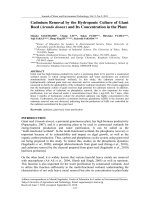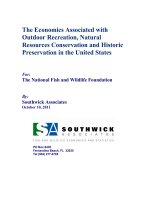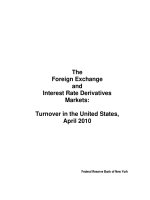- Trang chủ >>
- Khoa Học Tự Nhiên >>
- Vật lý
democratic drift majoritarian modification and democratic anomie in the united kingdom jan 2010
Bạn đang xem bản rút gọn của tài liệu. Xem và tải ngay bản đầy đủ của tài liệu tại đây (1.26 MB, 339 trang )
Democratic Drift
This page intentionally left blank
Democratic Drift
Majoritarian Modification and
Democratic Anomie in the United
Kingdom
Matthew Flinders
1
3
Great Clarendon Street, Oxford OX26DP
Oxford University Press is a department of the University of Oxford.
It furthers the University’s objective of excellence in research, scholarship,
and education by publishing worldwide in
Oxford New York
Auckland Cape Town Dar es Salaam Hong Kong Karachi
Kuala Lumpur Madrid Melbourne Mexico City Nairobi
New Delhi Shanghai Taipei Toronto
With offices in
Argentina Austria Brazil Chile Czech Republic France Greece
Guatemala Hungary Italy Japan Poland Portugal Singapore
South Korea Switzerland Thailand Turkey Ukraine Vietnam
Oxford is a registered trade mark of Oxford University Press
in the UK and in certain other countries
Published in the United States
by Oxford University Press Inc., New York
# Matthew Flinders 2010
The moral rights of the authors have been asserted
Database right Oxford University Press (maker)
First published 2010
All rights reserved. No part of this publication may be reproduced,
stored in a retrieval system, or transmitted, in any form or by any means,
without the prior permission in writing of Oxford University Press,
or as expressly permitted by law, or under terms agreed with the appropriate
reprographics rights organization. Enquiries concerning reproduction
outside the scope of the above should be sent to the Rights Department,
Oxford University Press, at the address above
You must not circulate this book in any other binding or cover
and you must impose the same condition on any acquirer
British Library Cataloguing in Publication Data
Data available
Library of Congress Cataloging in Publication Data
Data available
Typeset by SPI Publisher Services, Pondicherry, India
Printed in Great Britain
on acid-free paper by
the MPG Books Group
ISBN 978 0 19 927159 7
13579108642
Charlie, Indigo, Agnes, and Queenie—thanks for teaching me what really
matters in this world.
This page intentionally left blank
Contents
Acknowledgements ix
List of Figures xi
List of Tables xiii
List of Abbreviations xv
Part I: History, Theory, and Method
1. Constitutional Anomie 3
2. Meta-constitutional Orientations 17
3. Old Labour, New Labour, ‘Blair Paradox’ 35
4. Democratic Analysis 60
Part II: Patterns of Democracy
5. V1. Party System 91
6. V2. Cabinets 108
7. V3. Executive–Legislative Relationships 126
8. V4. Electoral System 145
9. V5. Interest Groups 161
10. V6. Federal–Unitary Dimension 181
11. V7. Unicameralism–Bicameralism 197
12. V8. Constitutional Amendment 215
13. V9. Judicial Review 238
14. V10. Central Bank Independence 255
vii
Part III: Bi-constitutionalism and the Governance of Britain
15. Bi-constitutionalism 273
16. Democratic Drift 287
Index 313
viii
Contents
Acknowledgements
As with most ventures of this kind, I have called upon a great number
of friends, colleagues, and scholars in the course of writing this book.
In terms of thanking and recognizing some of these individuals it
would be remiss of me not to begin by thanking Arend Lijphart. This
debt of gratitude relates not only to his original scholarship in the sphere
of democratic analysis but also to his willingness to engage and support
younger scholars as they seek to develop his initial framework and culti-
vate new intellectual terrains. In this context I would also like to highlight
the support I have received from Peter Mair. This book grew from an article
I was commissioned to write for West European Politics in 2005 and Profes-
sor Mair has remained a constant source of stimulation and inspiration
throughout the course of this project.
Many other people have provided guidance and feedback on specific
parts of this book, as well as the broader arguments I seek to make. These
include Andrew Gamble, Ben Seyd, Mark Evans, Richard Heffernan,
Charles Pattie, Meg Russell, Andrew Taylor, Paul Chaney, Sean Carey,
Alix Kelso, Stuart Weir, John Morison, Anthony Barnett, Patrick Dunleavy,
Fliss Matthews, Francesca Gains, Alistair McMillan, Gerry Stoker, Adrian
Vatter, Glenn Gottfried, Colin Hay, Andrew Russell, Roger Mortimer, Ben
Page, Guy Lodge, Dion Curry, Peter Jones, Richard Wyn Jones, Roger
Scully, David Moon, Michael Cole, Michael Gallagher, Michael Thrasher,
Rick Wilford, Robin Wilson, Mark Sandford, and Robert Hazell. I also owe
a debt of gratitude to the staff of the House of Commons Library, the
Bank of England, and Ipsos/MORI for the provision of statistical data.
The monitoring reports provided by the Constitution Unit were also an
invaluable resource throughout the writing of this book.
Various elements of this book were presented as papers at departmental
seminars and conferences around the world between 2006 and 2009 and
I would like to thank the participants at these events for their insightful
comments and suggestions for improvement. I was also involved in a
ix
number of international research networks and colloquia that helped
sharpen my arguments and theories in a number of ways. It is in this
context that I would like to thank David Erdos of Oxford University’s
Centre for Socio-Legal Studies for coordinating a project on Charter 88
and democratic change; Steven Fielding of Nottingham University for
convening a conference on the Conservative Party under David Cameron;
and Iain McLean and Varun Uberoi of Nuffield College, Oxford University,
for inviting me to contribute to the Future Options II project. I was also
fortunate enough to be involved with the Political Studies Association’s
formal response to the Governance of Britain green paper and a series of
subsequent events on the theme of constitutional reform under Gordon
Brown.
During the course of this project I was also fortunate enough to hold a
Leverhulme Trust Research Fellowship which afforded me a break from my
teaching and administrative responsibilities at the University of Sheffield,
and also access to a critical mass of documents and interviewees. The
sections of this book on parliamentary scrutiny and forms of legislative
oversight between 1997 and 2007 also drew upon research undertaken
alongside Alex Brazier and Declan McHugh of the Hansard Society under a
Nuffield Foundation funded audit of parliamentary modernization.
Finally, I would like to thank Dominic Byatt and Lizzy Suffling at Oxford
University Press for their editorial advice and guidance throughout this
project.
Matthew Flinders
May 2009
x
Acknowledgements
List of Figures
1.1 Public Attitudes on the political system in the UK, 1973 2008 10
4.1 Two dimensional map of democracy 78
4.2 Shifts on the two dimensional map from the period before 1971 to
the period 1971 96 80
5.1 Share of the vote: UK general elections, 1918 2005 96
5.2 Effective number of political parties, UK elections 1997 2008 105
6.1 Relationship between V1 (party systems) and V2 (cabinets) for the
UK and Scotland, Wales and Northern Ireland, 1997 2007 123
7.1 Relationship between V2 (cabinets) and V3 (executive legislative
relations) for the UK and devolved government 141
8.1 Seats won, UK general elections, 1918 2005 148
8.2 Votes cast and seats won by party, general election 2005 151
8.3 Dis proportionality scores, UK elections 1997 2008 153
8.4 Relationship between V1 (political parties) and V4 (electoral systems)
for the UK and devolved government 156
9.1 Relationship between V2 (cabinets) and V5 (interest group pluralism)
for the UK and devolved government 175
9.2 Relationship between V1 (political parties) and V5 (interest group
pluralism) for the UK and devolved government 175
11.1 Composition of the House of Lords by party, before and after
the House of Lords Act 1999 205
11.2 Relationship between V6 (division of power) and V7
(unicameralism bicameralism) for the UK 212
13.1 Relationship between V8 (constitutional rigidity) and V9
(judicial review) for the UK 252
14.1 Relationship between V6 (federalism) and V10 (central bank
independence) for the UK 265
14.2 Relationship between V9 ( judicial review) and V10
(central bank independence) for the UK 265
xi
15.1 Two dimensional conceptual map of democracy in the UK
(national and devolved) 276
16.1 Conservative Party options for change 296
16.2 Democratic change from a comparative perspective (1945 96,
1971 96, 1997 2007) 302
xii
List of Figures
List of Tables
2.1 Gradations of constitutional reform 19
2.2 Constitutional fuels 28
3.1 New Labour and the constitution: three phases 43
3.2 New Labour’s constitutional reforms 1997 2007 45
4.1 Strands of third wave literature on the UK’s constitution 68
4.2 Birch’s liberal and Whitehall views 74
4.3 Two dimensions and ten characteristics 77
4.4 Lijphart’s analysis of democracy in the UK, 1945 96 83
5.1 British general election statistics, results May 1997, June 2001,
and May 2005 95
5.2 Effective number of parties at UK general elections, 1974 2005 97
5.3 UK MEPs by party, 1979 2004 99
5.4 Elections to the National Assembly for Wales (constituency and
regional lists combined): 1999, 2003, and 2007 101
5.5 Elections to the Scottish Parliament (constituency and
regional lists combined): 1999, 2003, and 2007 102
5.6 Results of elections to the Northern Ireland Assembly: 1999,
2003, and 2007 103
5.7 Results of elections to the London Assembly (seats) 104
6.1 Forms of coalition government 110
6.2 Scottish Assembly, party strengths: 1999, 2003, and 2007 113
6.3 National Assembly for Wales, party strengths: 1999, 2003, and 2007 114
6.4 Northern Ireland Assembly, party strengths: 1999, 2003, and 2007 118
6.5 V2. Cabinets: multilevel analysis 120
7.1 Windows of opportunities and reforming parliaments 130
7.2 Average cabinet duration according to two criteria (in years), the
mean of these two measures, and the Index of Executive Dominance
in the UK, 1945 96, 1997 2007 135
xiii
8.1 Electoral systems in United Kingdom, 2008 146
9.1 Executive parties dimension: 1945 96, 1971 96, and 1997 2007 176
10.1 Degrees of federalism and decentralization in thirty six democracies,
1945 96 183
10.2 Asymmetrical devolution in the UK 186
11.1 Cameral structure of legislatures, 1945 96 201
11.2 Votes in the House of Commons (including tellers) on Lords
reform, 4 February 2003 203
12.1 Majorities and supermajorities required for constitutional
amendment in thirty six democracies 217
12.2 Legislation subject to the procedure for measures of ‘first class
constitutional significance’ 220
12.3 Role of the Upper House in passing constitutional amendments 223
12.4 Referendums in Western European Constitutions 227
12.5 Referendums in the UK, 1973 2007 229
12.6 Turnout for local referendums held under the Local
Government Act 2000 232
13.1 The strength of Judicial Review in thirty six democracies (1945 96) 241
13.2 Declarations of incompatibility under the Human Rights Act 1998 245
14.1 Central bank independence in thirty six democracies 259
15.1 Auditing reform in the UK under New Labour: Lijphart’s ten
variables and two dimensions 275
15.2 Meta constitutional orientations: core tenets 284
16.1 Conservative options for change 296
xiv
List of Tables
List of Abbreviations
AM Assembly Member
AMS Additional Member System
CWN Cukierman, Webb, and Neyapti
DCA Department for Constitutional Affairs
ECHR European Convention on Human Rights
FOI Freedom of Information
FPTP First Past the Post
GLA Greater London Assembly
GMT Grilli Masciandaro Tabellini
HLAC House of Lords Appointments Commission
IRA Irish Republican Army
JCHR Joint Committee on Human Rights
MMP Mixed Member Proportional
MPC Monetary Policy Committee
MSP Members of the Scottish Parliament
NAW National Assembly for Wales
NIA Northern Ireland Assembly
NIE Northern Ireland Executive
PLP Parliamentary Labour Party
PPR Public Policy Research
RC Regional Chambers
RDA Regional Development Agency
SGP Scottish Green Party
SSCUP Scottish Senior Citizens Unity Party
SSP Scottish Socialist Party
STUC Scottish Trade Unions Congress
xv
STV Single Transferable Vote
TUC Trades Union Congress
UK United Kingdom
UUP Ulster Unionist Party
WAG Welsh Assembly Government
xvi
List of Abbreviations
Part I:
History, Theory, and Method
This page intentionally left blank
Chapter 1
Constitutional Anomie
The constitution of the UK lives on, changing from day to day for the
constitution is no more and no less than what happens. Everything that
happens is constitutional. And if nothing happened that would be constitu
tional also.
1
Democracies around the world exist in a constant process of adaptation
and change. Although severe crises, such as war, disease, or natural disas-
ters may provoke ‘mega-political’ change in the sense of a fundamental
shift in the principles and institutional structures through which a coun-
try is governed, the general pattern of democratic evolution is based upon
incremental shifts in the nature of a democracy. This stability is rooted
in institutional and cultural path-dependencies that tend to ensure that
reforms are designed and implemented within a fairly narrow-bounded
rationality. Put slightly differently, most democracies possess, either im-
plicitly or explicitly, a form of constitutional morality which define the
key principles or values underlying the distribution of powers and political
relationships within that country. This constitutional morality provides a
form of socio-political roots or glue that, in turn, shape and mould not
only institutional arrangements, but also reform proposals.
For centuries the United Kingdom (UK) was regarded as the ‘Mother
of Democracy’ and its institutional framework and socio-political
culture were exported along colonial channels throughout the world. Its
constitutional morality was clear and broadly accepted—it was a power-
hoarding or majoritarian form of democracy. And yet at the beginning of
the twenty-first century, the nature and future of democracy in the UK are
highly contested. The election of New Labour in 1997 led to the introduc-
tion of a number of constitutional reforms that have been interpreted as
deconstructing, even ‘vandalising’, the UK’s traditional Westminster
Model democracy.
2
It is this debate that forms the context for this book.
3
1.1 Aims and arguments
This book seeks to gauge and understand the manner in which the nature
of democracy in the UK altered after the election of New Labour in 1997,
and is therefore a piece of constitutional political analysis. It achieves this
by drawing on the tools, language, and methods of comparative political
science in order to plot the degree and direction of democratic change.
More specifically, it draws upon Lijphartian political analysis in order
to provide a sharper account of New Labour’s statecraft in relation to
constitutional reform and democratic renewal. Sharper in the sense that
the contemporary nature of democracy in the UK cannot be captured
in simplistic statements concerning a shift from one democratic model
to another, but must instead be interpreted and understood through a
lens that is sensitive to the existence of parallel and incongruent models
of democracy. Indeed, it is the tension or grating between these coexisting
and competing forms of democracy, intended as they are to deliver quite
different governing principles, that explains many of the current chal-
lenges within domestic politics and emerging frameworks of multilevel
governance.
In order to understand the manner in which New Labour approached
the topic of constitutional reform and democratic renewal, and therefore
how the UK came to be institutionally configured, it is necessary to
appreciate both the political tradition in the UK and the historical men-
tality of the Labour Party. In this sense, New Labour came to power in 1997
within a context that was to some degree path-dependant. This created a
critical tension for the government between their pre-election rhetoric of
‘fundamental’ or ‘radical’ constitutional change, and their post-election
determination to retain the power of a strong state in order to protect their
governing capacity in terms of driving-through new policies and ensuring
delivery. New Labour responded to this tension in a typically British
manner: by ‘muddling through’ in the sense of ad hoc pragmatic re-
sponses to specific challenges, but without any clear statement of overall
intent or principled foundation. ‘Muddling through’, however, can be
interpreted as an inadequate response to the challenges of modern gover-
nance at the cusp of the twenty-first century. Instead of reconnecting the
governed and the governors or revitalizing politics, the available data and
survey evidence suggest that trust in traditional politics, politicians, and
political institutions appears to have declined during 1997–2007. It is in
explaining why such a significant number of constitutional reforms
Democratic Drift
4
should have failed to rebuild public trust in politics that this book is
concerned.
The focus of the explanation offered in this book rests on the distinction
(or gap) between rhetorical principles and governing practice and combines to
generate a clear thesis concerning what is termed ‘constitutional anomie’.
Constitutional anomie in this context relates to the manner in which New
Labour failed to offer an explicit account of what they were seeking to
achieve in the sphere of democratic reform, or why measures were viewed
as legitimate and acceptable in some areas or in relation to some issues but
not others. Put simply, between 1997 and 2007 the Labour governments of
Tony Blair suffered from constitutional anomie, and a series of reforms
were implemented with little appreciation of: (a) what (in the long run)
the government was seeking to achieve; (b) how reform in one sphere of
the constitution would have obvious and far-reaching consequences
for other elements of the constitutional equilibrium; or (c) any detailed
analysis of the nature or model of democracy that existed towards the
end of the twentieth century and particularly after eighteen years of
Conservative government.
Prime Minister Tony Blair made no speeches on the constitution and a
white paper on the constitution was never forthcoming. Blair was never a
constitutional entrepreneur with a driving passion for change or a clear
vision of what a reformed model of democracy in the UK would look like.
The Lord Chancellor for much of this period, Lord Irvine, responded
to criticisms that the reform programme was disjointed and opaque in
terms of under-pinning values by stating that the government had no
intention of ‘returning to first principles’. ‘Cobbled together on the back
of an envelope’ may well have been Hennessy’s apt description of consti-
tutional design and reform in the UK, but it arguably reached its zenith
during 2001–5 as a lack of consultation, inadequate preparatory work,
and poor media management led to the government being perceived as
floundering, ill-prepared, overhasty, and, at times, simply shoddy in rela-
tion to constitutional reform.
It is this accusation of constitutional anomie that provides the context
or backcloth on which this book is written. The central question this book
seeks to answer—and therefore around which its theoretical and empirical
arguments revolve—is how exactly did New Labour alter the nature of
democracy in the UK during 1997–2007?
In this context, the publication of the Governance of Britain green paper
in July 2007, just weeks after Tony Blair resigned and was replaced by
Gordon Brown marks a significant point in the constitutional history of
Constitutional Anomie
5
the UK.
3
As Chancellor of the Exchequer, Brown had always been more
sensitive to the existence and implications of constitutional anomie, and
during the government’s second term (2001–5) he signalled his anxieties
in a number of speeches and statements in which he called for a ‘new
constitutional settlement’.
4
Governance of Britain can therefore be located
within a broader narrative concerning the evolution and future of democ-
racy. In terms of style there is a distinct change of emphasis in two clear
ways: first, there is an explicit engagement and willingness to promote a
discussion about the primary values and principles that should underpin
the UK’s constitutional arrangements; and, second, there is an emphasis
on broad consultation in relation to both underpinning values and ele-
ments of ‘unfinished business’ (electoral reform for the House of Com-
mons, reform of the second chamber, etc.). However, the green paper also
provides an intriguing glance into the executive mentality and particular-
ly how members of the government and senior civil servants frame certain
issues in terms of key questions. In this regard it is possible to suggest that
the document is misdirected. The foreword by the Prime Minister, Gordon
Brown, and Secretary of State for Justice and the Lord Chancellor, Jack
Straw, states that the Governance of Britain is focused on two fundamental
questions:
1. How should we hold power accountable?
2. How should we uphold and enhance the rights and responsibilities of
the citizen?
However, it is possible to suggest that these two questions continue
to suggest a degree of constitutional anomie because they are secondary
or meso-level questions that can only be answered once broader macro-
political questions regarding what sort of democracy, what specific model
or form, we are seeking to evolve towards have been settled. Put slightly
differently, there are many ways of holding power to account and there
are many mechanisms through which rights and responsibilities can be
entrenched and secured but these variations tend to flow—like branches
from a tree—from the specific form of democracy (parliamentary, presi-
dential, majoritarian, consociational) deployed within that polity. Adopt-
ing the metaphor of a journey, the government’s questions are akin to
discussing what form of transport we might use (train, bus, plane, tram,
etc.) before we have decided where we want to go. Following this line
of argument it is possible to suggest that if the government is truly com-
mitted to forging ‘a new relationship between government and citizen,
and beginning the journey towards a new constitutional settlement’ then
Democratic Drift
6
a more constructive approach would take a more expansive and grounded
stanae by asking two quite different questions:
1. What kind of constitution and democracy do we have in the UK at the
beginning of the twenty-first century?
2. What are we attempting to achieve through the reform process?
These questions are clearly interrelated as answering the second requires at
least some attempt at resolving the first. Both questions also involve
normative and empirical dimensions which, in turn, force us to consider
the tools of political analysis, and particularly those that offer the capacity
to assess the sum impact of a series of constitutional measures. This
raises epistemological and methodological questions concerning the con-
cepts, theories, and frameworks through which it is possible to deduce
subtle, moderate,orfundamental changes in a democratic system. However,
the significance of these questions of political analysis and the need
for explicitly theorized systematic research on the impact/legacy of re-
forms during 1997–2007 is demonstrated not just by the current Labour
government’s position on constitutional reform, but also by the failure
of the now burgeoning academic literature on this topic to come to any
sort of shared conclusion about the impact of these measures.
A clear polarization of opinion can be identified within the scholarly
analysis between those who have interpreted New Labour’s impact on
the constitution as fundamental and those more sceptical observers who
view the very same reforms as involving a far less radical, even cosmetic
effect on democracy in the UK. In this context Peter Mair observes, ‘New
Labour is currently engaged in what amounts to a full-blooded constitu-
tional revolution, dragging the political system away from an extreme
version of majoritarian democracy towards a more institutionally consen-
sual model’ while Mark Evans rejects such an interpretation and argues
that ‘Third Way democracy is elite democracy in disguise’.
5
This polariza-
tion of opinion is intriguing because it forces us to reflect on the methods
and tools of political analysis that can be utilized in order to tease apart
and disentangle a complex patchwork of reforms, and thereby reveal the
underlying drivers or consequences of this process.
This vast body of work provides the backdrop against which this book
stands. The central epistemological and methodological argument of
this book is that a binary distinction between consensual or majoritarian
models of democracy is inappropriate because it fails to reflect the true
complexity that currently exists. As a result this book develops the concept
of ‘meta-constitutional orientations’ in order to argue that the distinctive
Constitutional Anomie
7
element of New Labour’s approach to constitutional engineering is not
that it has shifted the nature of democracy in the UK from one model
to another, but that it has sought to apply different models at the periph-
ery and core: bi-constitutionality. Revealing the existence of overlapping
or intertwined models of democracy provides a sharper understanding
of the realities of modern governance through which it is possible to
understand the polarization of academic opinion and many of the key
challenges facing democracy in the UK.
In order to provide depth (in terms of a conceptual and theoretical
framework) and breadth (in terms of a structure through which it is
possible to identify the interrelationship between specific reforms) this
book utilizes Arend Lijphart’s framework for measuring patterns of democ-
racy.
6
This contributes a deeper understanding and more fundamental
analysis to the broader debate about how the constitution and nature of
democracy has altered in the UK since May 1997. It therefore provides a
way of teasing apart and understanding the roots of the academic debate
on the cumulative impact of New Labour’s reforms and through this
provide an answer to the first question mentioned earlier (‘What kind
of constitution and democracy do we have in the UK at the beginning of
the twenty-first century?’), that will itself aid our understanding of the
trajectory of UK politics and from this provide a clearer foundation and
basis from which to debate the second question (‘What are we attempting
to achieve through the reform process?’).
Briefly focusing on this latter question at this early stage is useful for a
number of reasons, but not least because it encourages us to reflect on New
Labour’s original aims and ambitions and then consider the degree to
which they have been achieved. This then sets out the broader context
or background within which not only Governance of Britain was published
by the government in July 2007, but also within which the research in this
book was conducted. It is for this reason that Section 1.2 focuses on the
analysis of levels of public trust in politics.
1.2 The Democratic legacy, 1997–2007
In January 2006, the Minister for Constitutional Affairs, Harriet Harman,
emphasized that ‘[A] healthy democracy is one that has the active engage-
ment of its citizens. Our democracy lacks legitimacy if, whatever the
formal rules about universal suffrage and the right to vote, people don’t
make it a reality by turning out to vote’.
7
The Minister went on to lament
Democratic Drift
8









